Differential Interference Contrast (DIC) for DIY Cerna® Systems
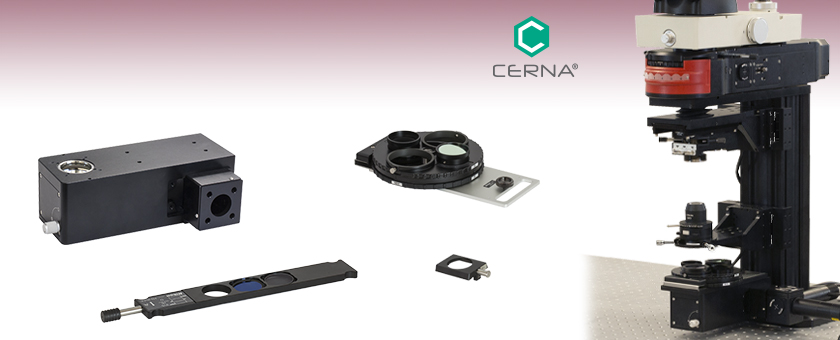
- Generate High-Contrast Images of Thin, Unlabeled Samples
- Illumination Module Conditions Transmitted Light
- Polarizers, Condenser Prisms, Objective Prisms,
and Analyzer for Visible and IR
WFA3110
DIC Analyzer for Visible and IR
WFA1000
DIC Illumination Module
WFA3143
DIC Objective Prism for Nikon 25X Objectives
WFA3100
Polarizer Turret
DIY Cerna® System
Configured for
DIC Imaging

Please Wait
| System Requirements for DIC | |
|---|---|
| Component | Requirements |
| Microscope Body | At Least 400 mm Rail Height |
| Trans-Illumination Source |
Emission Within 400 - 1000 nm Wavelength Range; Collimated and Coupled into 30 mm Cage System |
| Condensera | CSC1001 or CSC1002, or CSC2001 with CN1 or CN2 Tray |
| Objective Mounting | CSN1201 or CSN1202 Nosepiece |
| Epi-Illuminator Module | CSE2000, CSE2100, or CSE2200 |
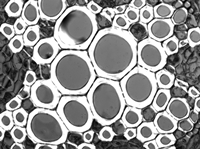
Click to Enlarge
DIC Image of a Buttercup Root
Features
- DIC Illumination Module Accepts Collimated Illumination Through Ø1" Optical Input Port
- Optical Input and Output Ports are 30 mm Cage Compatible
- 95 mm Dovetail Clamp Attaches Illumination Module to Microscope Body
- Optical Elements for Performing Differential Interference Contrast (DIC) in Visible & IR
- Polarizer Turret with ND Filter Wheel and Slots for DIC Polarizers
- Condenser Prisms for Use with N1 or N2 Objectives
- Objective Prisms (Sliders) Matched to Specific Nikon Objectives
- Analyzer for Visible and IR DIC Signals
- Designed for 7.74" Throat Depth of DIY Cerna® Systems
This webpage contains Thorlabs' selection of components for performing differential interference contrast (DIC) imaging in DIY Cerna systems. DIC imaging is an extremely popular method for obtaining contrast from thin unlabeled samples in vitro.
When mounted to a Cerna microscope body using the WFA0150 Dovetail Clamp, our WFA1000 Trans-Illumination Module will direct illumination along an optical axis 7.74" away from the edge of the vertical support rail. The module is compatible with any collimated illumination source coupled into a 30 mm cage system, such as an illumination kit. To complement the trans-illumination module, we offer DIC polarizers, condenser prisms, objective prisms (sliders), and an analyzer that manipulate the polarized light which goes through the sample. Our condenser and objective prisms are Nomarski modified.
System Requirements
Please note that when configuring a Cerna system for DIC, the microscope body needs to be tall enough to make room for all of the needed optical elements. In addition, the condenser, objective mounting apparatus, and epi-illuminator module need to have slots for the condenser prism, objective prism, and analyzer, respectively. Our recommendations are shown in the "System Requirements for DIC" table above.
Other Transmitted Light Imaging Modalities
We also support Dodt contrast and brightfield and oblique illumination for DIY Cerna systems. These imaging modalities are easier to add to Cerna systems because they do not require a particular minimum rail height, objective nosepiece, or epi-illuminator module. As a rule of thumb, Dodt contrast generates images with slightly less maximum contrast than DIC, but it also maintains its performance over a greater range of sample thicknesses. For more details, see the Imaging Modalities tab.

The red and blue rays generated at the condenser prism represent orthogonal polarization states. For readability, the separation between the rays has been exaggerated; the distance between them in a sample is less than the diameter of an Airy disk.
Nomarski DIC Schematic
DIC imaging generates contrast using several polarization-manipulating optics. The illumination source is first polarized, then split into two spatially separated, orthogonally polarized beams of equal intensity by the Nomarski-modified condenser prism. These two beams are directed onto the sample.
Within the sample, each beam experiences a different optical path length. This path length difference can be caused by changes in the refractive index, such as those between cell interfaces or those due to birefringence, and it can also be caused by variations in the specimen's thickness over the field of view. The two beams are spatially recombined at the Nomarski-modified objective prism, allowing optical interference between them to occur. This (sample-induced) interference pattern is resolved by the analyzer, which creates differences in intensity that can be viewed on a camera.
Cerna® microscopes support several imaging modalities, including epi-fluorescence, brightfield illumination, differential interference contrast (DIC) imaging, and Dodt gradient contrast imaging. Each of these methods requires different accessories and confers different advantages to the microscopist, as described below.
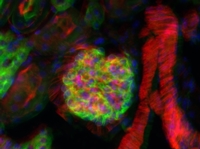
Click to Enlarge
Epi-Fluorescence Image of Mouse Kidney with Multiple Labels
Epi-Fluorescence
Epi-fluorescence makes use of fluorescent labels and intrinsic fluorescence in a specimen to identify sample features. To create an epi-fluorescence image, light that has been passed through an excitation filter is directed through an objective and absorbed by a sample. This excitation causes fluorophores within the sample to emit light of a longer wavelength (i.e., lower energy) than the excitation light. Some of this emitted light is collected by the objective, which helps direct the emission onto a camera for observation. Additional details on this imaging modality are available here.
For performing epi-fluorescence measurements in DIY Cerna systems, we offer a range of widefield viewing and epi-illumination accessories, as well as fluorescence filter sets targeted at common fluorophores.
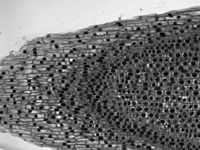
Click for Details
Brightfield Image of Onion Mitosis
Brightfield Illumination
Brightfield illumination is the simplest method of trans-illumination. In this modality, light from an illumination source is collected by a condenser and passed through a sample, which is observed by its effect on the intensity of the transmitted light. Brightfield illumination only requires an illumination source (i.e., an illumination kit) and a condenser to be attached to a DIY Cerna system.

Click to Enlarge
DIC Image of a Buttercup Root
DIC Imaging
In differential interference contrast (DIC) imaging, light transmitted through the sample is manipulated by a number of polarization optics. Light from the illumination source is polarized and then split into two orthogonally polarized beams before it reaches the sample. Small differences in the optical path length experienced by the two beams cause interference when the beams are recombined, providing enhanced contrast for sample features that would be transparent under brightfield illumination. In addition to an illumination source and a condenser, DIC imaging requires several additional optical elements: a DIC polarizer, a condenser prism, an objective prism, and an analyzer.
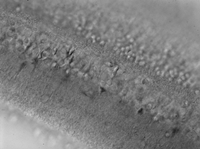
Click to Enlarge
Dodt Contrast Image of a Mouse Retina
Dodt Contrast
Dodt gradient contrast, also known more simply as Dodt contrast, can be understood as an improvement upon oblique illumination. Both methods use a mask to generate an illumination gradient, but in Dodt contrast, the mask occurs much earlier in the optical path. This configuration improves the image contrast to a point where it is comparable to that obtained using DIC.
The Dodt illumination gradient is generated using a specially shaped quarter annulus and diffusers, and reveals thickness changes in a sample over the field of view. Compared to brightfield illumination, Dodt contrast offers improved resolution of sample features, and compared to DIC, it allows thicker samples to be studied. Thorlabs manufactures a pre-configured, pre-aligned illumination module for Dodt contrast that generates the desired gradient; it requires an illumination source and a condenser for operation.
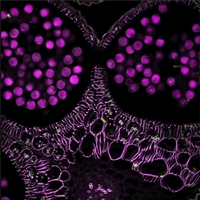
Click to Enlarge
Laser Scanned Image of a Flower Bud
Laser Scanning
Like epi-fluorescence, laser scanning makes use of fluorescent labels and intrinsic fluorescence in a specimen to identify sample features. Unlike epi-fluorescence, laser scanning is able to resolve thin individual planes relatively deep into a thick sample, enabling 3D volumetric images and opening the door to in vivo studies.
Laser scanning techniques (e.g., multiphoton and confocal microscopy) rely upon the coherence of laser beams to provide significantly improved axial resolution. In confocal microscopy, a pinhole eliminates the out-of-focus light that would reduce the axial resolution (as it does in epi-fluorescence), while in multiphoton microscopy, the necessity of two- or three-photon absorption by the fluorophore, a low-probability event, effectively creates optical sections.
Additional details are available at our laser scanning microscopy tutorial.
Building a Cerna® Microscope
The Cerna microscopy platform's large working volume and system of dovetails make it straightforward to connect and position the components of the microscope. This flexibility enables simple and stable set up of a preconfigured microscope, and provides easy paths for later upgrades and modification. See below for a couple examples of the assembly of some DIY Cerna microscopes.
DIY Cerna Design and Assembly
Walkthrough of a DIY Microscope Configuration
This DIY microscope uses a CSA3000(/M) Breadboard Top, a CSA2001 Dovetail Adapter, our CSA1001 and CSA1002 Fixed Arms, and other body attachments and extensions. These components provide interfaces to our lens tube and cage construction systems, allowing the rig to incorporate two independent trans-illumination modules, a home-built epi-illumination path, and a custom sample viewing optical path.
The simplicity of Thorlabs optomechanical interfaces allows a custom DIY microscope to be quickly assembled and reconfigured for custom imaging applications.
| Posted Comments: | |
Haohua Tu
(posted 2022-06-11 13:32:03.127) What is the typical distance between the objective prism and the back edge of the microscope objective. I am evaluating if this distance is long enough to integrate DIC with multi-photon microscopy. cdolbashian
(posted 2022-06-21 02:07:13.0) Thank you for reaching out to us with this inquiry. I have contacted you directly to discuss exact dimension you are asking after. wenzel.jakob
(posted 2017-11-27 16:47:50.053) I had the following two questions about DIC in a Cerna microscope:
1. Is DIC supported in the epi-illumination setting? Where does the polarizer on the light source side go?
2. Thorlabs offers DIC prisms for Plan fluorite objectives up to 40x, but e.g. not 60x (dry) or 100 x (oil). Do these exist and if so, what's the way to obtain them? (e.g. by directly contacting Nikon? What item numbers should I ask for in this case?) tfrisch
(posted 2018-02-14 03:57:48.0) Hello, thank you for contacting Thorlabs. DIC is an imaging technique in which the light must pass through the sample, and then there are slight phase differences between polarization states at the edges which cause interference changes and yield the high contrast. I am not familiar with a method that would provide the same results using epi-illumination. As for the prisms, I will reach out to you directly about the condenser and objective you are using as the prisms needs to match those. oliver.larkin
(posted 2015-07-07 12:37:25.56) I was recommended a similar setup to the WFA1010 by you previously, but the illumination isn't ideal. Looking at the product I already have the LED, driver, filter cube and tubing, can you tell me what the internal geometry and lens system is as I would like to upgrade my system to this layout. besembeson
(posted 2015-09-23 09:40:24.0) Response from Bweh at Thorlabs USA: The internal geometry and the multiple lens system configuration is proprietary. We can provide a blackbox model if needed. |
Click on the different parts of the microscope to explore their functions.
Elements of a Microscope
This overview was developed to provide a general understanding of a Cerna® microscope. Click on the different portions of the microscope graphic to the right or use the links below to learn how a Cerna microscope visualizes a sample.
Terminology
Arm: Holds components in the optical path of the microscope.
Bayonet Mount: A form of mechanical attachment with tabs on the male end that fit into L-shaped slots on the female end.
Bellows: A tube with accordion-shaped rubber sides for a flexible, light-tight extension between the microscope body and the objective.
Breadboard: A flat structure with regularly spaced tapped holes for DIY construction.
Dovetail: A form of mechanical attachment for many microscopy components. A linear dovetail allows flexible positioning along one dimension before being locked down, while a circular dovetail secures the component in one position. See the Microscope Dovetails tab or here for details.
Epi-Illumination: Illumination on the same side of the sample as the viewing apparatus. Epi-fluorescence, reflected light, and confocal microscopy are some examples of imaging modalities that utilize epi-illumination.
Filter Cube: A cube that holds filters and other optical elements at the correct orientations for microscopy. For example, filter cubes are essential for fluorescence microscopy and reflected light microscopy.
Köhler Illumination: A method of illumination that utilizes various optical elements to defocus and flatten the intensity of light across the field of view in the sample plane. A condenser and light collimator are necessary for this technique.
Nosepiece: A type of arm used to hold the microscope objective in the optical path of the microscope.
Optical Path: The path light follows through the microscope.
Rail Height: The height of the support rail of the microscope body.
Throat Depth: The distance from the vertical portion of the optical path to the edge of the support rail of the microscope body. The size of the throat depth, along with the working height, determine the working space available for microscopy.
Trans-Illumination: Illumination on the opposite side of the sample as the viewing apparatus. Brightfield, differential interference contrast (DIC), Dodt gradient contrast, and darkfield microscopy are some examples of imaging modalities that utilize trans-illumination.
Working Height: The height of the support rail of the microscope body plus the height of the base. The size of the working height, along with the throat depth, determine the working space available for microscopy.
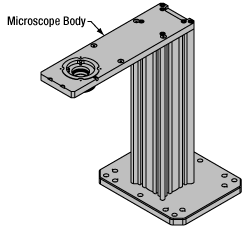 Click to Enlarge
Click to EnlargeCerna Microscope Body
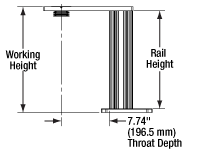
Click to Enlarge
Body Details
Microscope Body
The microscope body provides the foundation of any Cerna microscope. The support rail utilizes 95 mm rails machined to a high angular tolerance to ensure an aligned optical path and perpendicularity with the optical table. The support rail height chosen (350 - 600 mm) determines the vertical range available for experiments and microscopy components. The 7.74" throat depth, or distance from the optical path to the support rail, provides a large working space for experiments. Components attach to the body by way of either a linear dovetail on the support rail, or a circular dovetail on the epi-illumination arm (on certain models). Please see the Microscope Dovetails tab or here for further details.
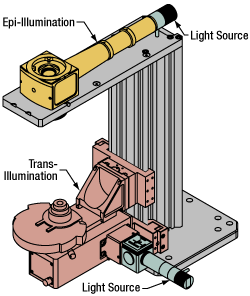 Click to Enlarge
Click to EnlargeIllumination with a Cerna microscope can come from above (yellow) or below (orange). Illumination sources (green) attach to either.
Illumination
Using the Cerna microscope body, a sample can be illuminated in two directions: from above (epi-illumination, see yellow components to the right) or from below (trans-illumination, see orange components to the right).
Epi-illumination illuminates on the same side of the sample as the viewing apparatus; therefore, the light from the illumination source (green) and the light from the sample plane share a portion of the optical path. It is used in fluorescence, confocal, and reflected light microscopy. Epi-illumination modules, which direct and condition light along the optical path, are attached to the epi-illumination arm of the microscope body via a circular D1N dovetail (see the Microscope Dovetails tab or here for details). Multiple epi-illumination modules are available, as well as breadboard tops, which have regularly spaced tapped holes for custom designs.
Trans-illumination illuminates from the opposite side of the sample as the viewing apparatus. Example imaging modalities include brightfield, differential interference contrast (DIC), Dodt gradient contrast, oblique, and darkfield microscopy. Trans-illumination modules, which condition light (on certain models) and direct it along the optical path, are attached to the support rail of the microscope body via a linear dovetail (see Microscope Dovetails tab or here). Please note that certain imaging modalities will require additional optics to alter the properties of the beam; these optics may be easily incorporated in the optical path via lens tubes and cage systems. In addition, Thorlabs offers condensers, which reshape input collimated light to help create optimal Köhler illumination. These attach to a mounting arm, which holds the condenser at the throat depth, or the distance from the optical path to the support rail. The arm attaches to a focusing module, used for aligning the condenser with respect to the sample and trans-illumination module.
 |
 |
 |
 |
 |
 |
 |
 |
| Epi-Illumination Modules | Breadboards & Body Attachments |
Brightfield | DIC | Dodt | Condensers | Condenser Mounting | Light Sources |
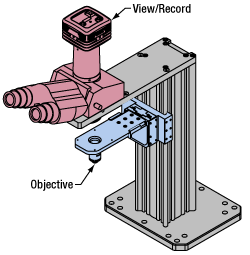 Click to Enlarge
Click to EnlargeLight from the sample plane is collected through an objective (blue) and viewed using trinocs or other optical ports (pink).
Sample Viewing/Recording
Once illuminated, examining a sample with a microscope requires both focusing on the sample plane (see blue components to the right) and visualizing the resulting image (see pink components).
A microscope objective collects and magnifies light from the sample plane for imaging. On the Cerna microscope, the objective is threaded onto a nosepiece, which holds the objective at the throat depth, or the distance from the optical path to the support rail of the microscope body. This nosepiece is secured to a motorized focusing module, used for focusing the objective as well as for moving it out of the way for sample handling. To ensure a light-tight path from the objective, the microscope body comes with a bellows (not pictured).
Various modules are available for sample viewing and data collection. Trinoculars have three points of vision to view the sample directly as well as with a camera. Double camera ports redirect or split the optical path among two viewing channels. Camera tubes increase or decrease the image magnification. For data collection, Thorlabs offers both cameras and photomultiplier tubes (PMTs), the latter being necessary to detect fluorescence signals for confocal microscopy. Breadboard tops provide functionality for custom-designed data collection setups. Modules are attached to the microscope body via a circular dovetail (see the Microscope Dovetails tab or here for details).
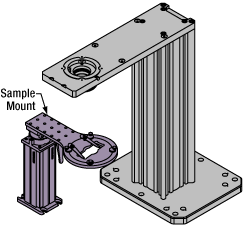 Click to Enlarge
Click to EnlargeThe rigid stand (purple) pictured is one of various sample mounting options available.
Sample/Experiment Mounting
Various sample and equipment mounting options are available to take advantage of the large working space of this microscope system. Large samples and ancillary equipment can be mounted via mounting platforms, which fit around the microscope body and utilize a breadboard design with regularly spaced tapped through holes. Small samples can be mounted on rigid stands (for example, see the purple component to the right), which have holders for different methods of sample preparation and data collection, such as slides, well plates, and petri dishes. For more traditional sample mounting, slides can also be mounted directly onto the microscope body via a manual XY stage. The rigid stands can translate by way of motorized stages (sold separately), while the mounting platforms contain built-in mechanics for motorized or manual translation. Rigid stands can also be mounted on top of the mounting platforms for independent and synchronized movement of multiple instruments, if you are interested in performing experiments simultaneously during microscopy.

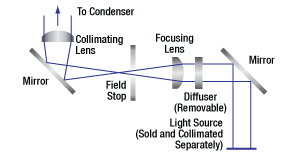
Click to Enlarge
DIC Illumination Module Schematic
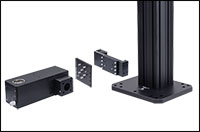
Click to Enlarge
The WFA1000 Illumination Module is positioned in the optical path by the WFA0150 Dovetail Clamp.
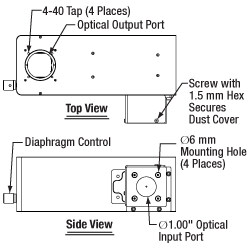
Click for Details
Drawing of Trans-Illumination Module
- Trans-Illumination Module Mounts User-Provided Illumination Source
- 95 mm Dovetail Clamp Connects Module to Microscope Body
The WFA1000 Trans-Illumination Module steers the light from a user-provided illumination source into the transmitted light optical path. It is designed for the 400 - 1000 nm wavelength range.
As shown in the drawings to the right, the collimated illumination is accepted through a Ø1" input port on the side of the module. To mount an illumination source to this port, the module accepts cage rods via four Ø6 mm bores spaced for our 30 mm cage system. Locking setscrews for these cage rods can be accessed by removing a dust cover that is held in place with a 1.5 mm hex button head screw, as shown in the drawing to the right. Our illumination kits are specifically designed for use with this input port, and four ER025 cage rods for these kits are included with the module. If using another light source, note that for best performance, the input port should be filled.
The rotating knob on the front controls an integrated field stop diaphragm, which can be used to adjust the illumination intensity and match the back aperture of a condenser. A diffuser comes pre-installed inside the module in order to homogenize the output light. If desired, the user can access and easily remove this diffuser by unscrewing four #1 Phillips-head screws on the side of the module. 30 mm cage compatibility for the output port is provided by four 4-40 taps.
The WFA0150 Dovetail Clamp, sold separately, is used to connect the trans-illumination module to the microscope body. This 95 mm dovetail clamp is attached to the trans-illumination module by the included adapter plate, as shown in the image above. The clamp and adapter plate together position the optical output port at the 7.74" throat depth used in DIY Cerna systems.


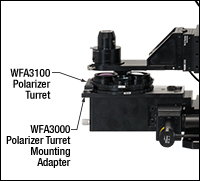
Click to Enlarge
The WFA3000 mounting adapter is used to secure the WFA3100 polarizer turret onto the trans-illumination module.
- Illumination Source is Polarized by WFA3120 Visible Polarizer or WFA3121 IR Polarizer
- WFA3100 Polarizer Turret has ND Filter Wheel and Slots for Polarizers
- WFA3000 Turret Mounting Adapter Secures Polarizer Turret to Trans-Illumination Module
The WFA3100 Polarizer Turret and WFA3000 Turret Mounting Adapter are used to mount DIC polarizers onto the WFA1000 Trans-Illumination Module shown above.
DIC Polarizers
The WFA3120 and WFA3121 consist of a polarizer and a quarter-wave plate (i.e., a de Sénarmont compensator) that have been combined into a single housing. Each housing has gear teeth that enable smooth rotation of the polarizer through 360° without changing the orientation of the quarter-wave plate. Each polarizer therefore controls whether linearly polarized, circularly polarized, or elliptically polarized light is incident on the specimen, letting the experimenter fine tune the system for the greatest possible sensitivity. To allow the polarizers to rotate, the WFA3100 polarizer turret includes two knurled rings. The knurled ring that is located clockwise from the polarizer rotates it.
Polarizer Turret
The WFA3100 Polarizer Turret's bottom wheel has four positions (empty, ND 2, ND 4, and ND 16), while the top wheel ships with three empty slots and a color-temperature-balancing filter. Two of the empty slots on the top wheel are sized to fit the WFA3120 Visible Polarizer and the WFA3121 IR Polarizer, which are sold separately, while the third empty slot is intentionally left empty for situations that only require brightfield illumination. An M5 thumbscrew connects the turret to the WFA3000 mounting adapter.
Turret Mounting Adapter
The WFA3000 Turret Mounting Adapter secures the WFA3100 polarizer turret onto the WFA1000 trans-illumination module and aligns the module's optical output port with one of the positions on the turret. It contains four M3 counterbores that are spaced to mate with four M3 tapped holes on top of the module, as well as one M5 tapped hole that mates with the polarizer turret. Four M3 button head screws are included with the adapter.
The relative thickness of the polarizer turret and turret mounting adapter is a key reason why microscope bodies with rail heights less than 400 mm do not support DIC imaging.


| Condenser Prism Item # |
Type | Compatible Objective | |
|---|---|---|---|
| Item # | Description | ||
| WFA3130 | N1 | N10X-PF | Nikon Plan Fluorite, 10X |
| WFA3131 | N2 | N16XLWD-PF | Nikon, 16X |
| N20X-PF | Nikon Plan Fluorite, 20X | ||
| N25X-APO-MP N25X-APO-MP1300 |
Nikon, 25X | ||
| N40X-PF | Nikon Plan Fluorite, 40X | ||
| N40X-NIR | Nikon APO NIR, 40X, Water Immersion | ||
| N60X-NIR | Nikon APO NIR, 60X, Water Immersion | ||
- Polarized Input Light is Split by Condenser Prism
- WFA3130 Condenser Prism is Used with N1 Objectives
- WFA3131 Condenser Prism is Used with N2 Objectives
- Designed for Use with CSC1001, CSC1002, and CSC2001 Condensers
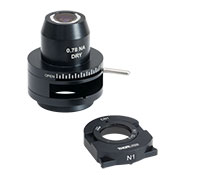
Click to Enlarge
The CSC2001 condenser is compatible with the WFA3130 and WFA3131 condenser prisms via the CN1 and CN2 trays (CN1 shown above).
Condenser prisms accept the polarized light from the DIC polarizers described above. When the optical axis of the prism is aligned at 45° with respect to the input polarization, the prism will split the input beam into two spatially separated, orthogonally polarized beams of equal intensity. These spatially separated, orthogonally polarized beams make the DIC method sensitive to refractive index and thickness changes across the field of view, as described in the Overview tab.
The WFA3130 Condenser Prism is used with N1 objectives, while the WFA3131 Condenser Prism is used with N2 objectives. The housings of DIC-compatible objectives are typically engraved with either "N1" or "N2". You should verify that this engraving matches the condenser prism to ensure compatibility. Both of our prisms are Nomarski modified.
Our CSC1001, CSC1002, and CSC2001 condensers contain internal turrets or slots for trays that accept these condenser prisms.


| Objective Prism Item # |
Compatible Objective | Compatible Nosepiece Item # |
|
|---|---|---|---|
| Item # | Description | ||
| WFA3140 | N10X-PF | Nikon Plan Fluorite, 10X | CSN1202 |
| WFA3141 | N16XLWD-PF | Nikon, 16X | CSN1201 |
| WFA3142 | N20X-PF | Nikon Plan Fluorite, 20X | CSN1202 |
| WFA3143 | N25X-APO-MP N25X-APO-MP1300 |
Nikon, 25X | CSN1201 |
| WFA3144 | N40X-NIR | Nikon APO NIR, 40X, Water Immersion | CSN1202 |
| WFA3145 | N40X-PF | Nikon Plan Fluorite, 40X | CSN1202 |
| WFA3146 | N60X-NIR | Nikon APO NIR, 60X, Water Immersion | CSN1202 |
- Objective Prism Recombines Light onto Single Optical Path After the Sample
- Each Prism is Matched to a Specific Objective (See Table to the Right)
- Designed to Fit into CSN1201 and CSN1202 Nosepieces
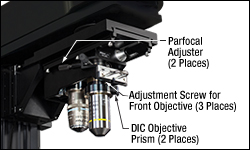
Click to Enlarge
The image above shows the integration of a DIC objective prism with the CSN1202 Dual-Objective Nosepiece.
After the two spatially separated, orthogonally polarized beams generated by the condenser prism travel through the sample, they are recombined by the objective prism. If the sample has changes in refractive index and/or thickness across the field of view, as described in the Overview tab, the two beams will have experienced different optical path lengths.
Objective prisms, also known as sliders, are designed for use with particular objectives. The table to the right summarizes the objective prism compatibility. All of our objective prisms are Nomarski modified.
These objective prisms are designed to fit into specially designed slots in the CSN1201 and CSN1202 Objective Nosepieces. If using another nosepiece, a custom mounting solution will be required.


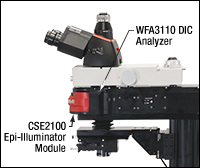
Click to Enlarge
The WFA3110 DIC analyzer is mounted in a specially designed slot on certain Cerna epi-illuminator modules.
- WFA3110 DIC Analyzer Resolves Changes Between Different Sample Regions
- Includes Empty Slot, Visible Analyzer, and IR Analyzer
- Designed to Fit into CSE2000, CSE2100, and CSE2200 Epi-Illuminator Modules
The final DIC element in the optical path is the DIC analyzer. It effectively converts the differences in optical path length across the field of view into differences in intensity that can be resolved by the widefield viewing apparatus (e.g., a camera or trinoculars). One slot on the analyzer is intentionally left empty for situations that only require brightfield illumination. The other two slots are filled by a visible analyzer (i.e., a non-rotating polarizer) and an IR analyzer.
The WFA3110 DIC Analyzer is designed to fit into a specially designed slot in the CSE2000, CSE2100, and CSE2200 Epi-Illuminator Modules, which have detents that stop the WFA3110 at each of its three slots. It is important to insert this analyzer right-side up (i.e., with the labels facing upward), or it can become stuck in the epi-illuminator module. If using another epi-illuminator module, a custom mounting solution will be required.
Please note that the CSD1001 Double Camera Port includes a built-in IR analyzer for the rear camera port. If your Cerna system has this double camera port and visible DIC imaging is not needed, then the WFA3110 analyzer is not required.

 Products Home
Products Home
















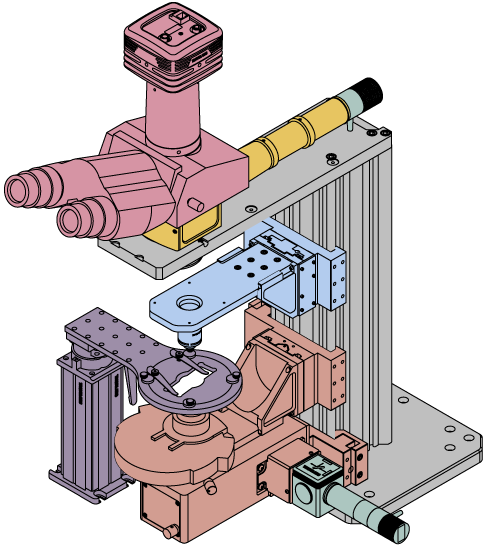























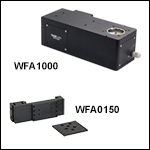
 Zoom
Zoom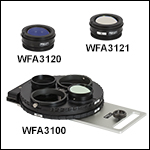
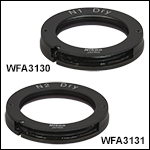
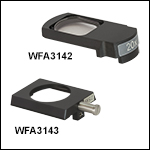
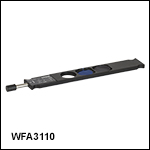
 Trans-Illumination: DIC
Trans-Illumination: DIC